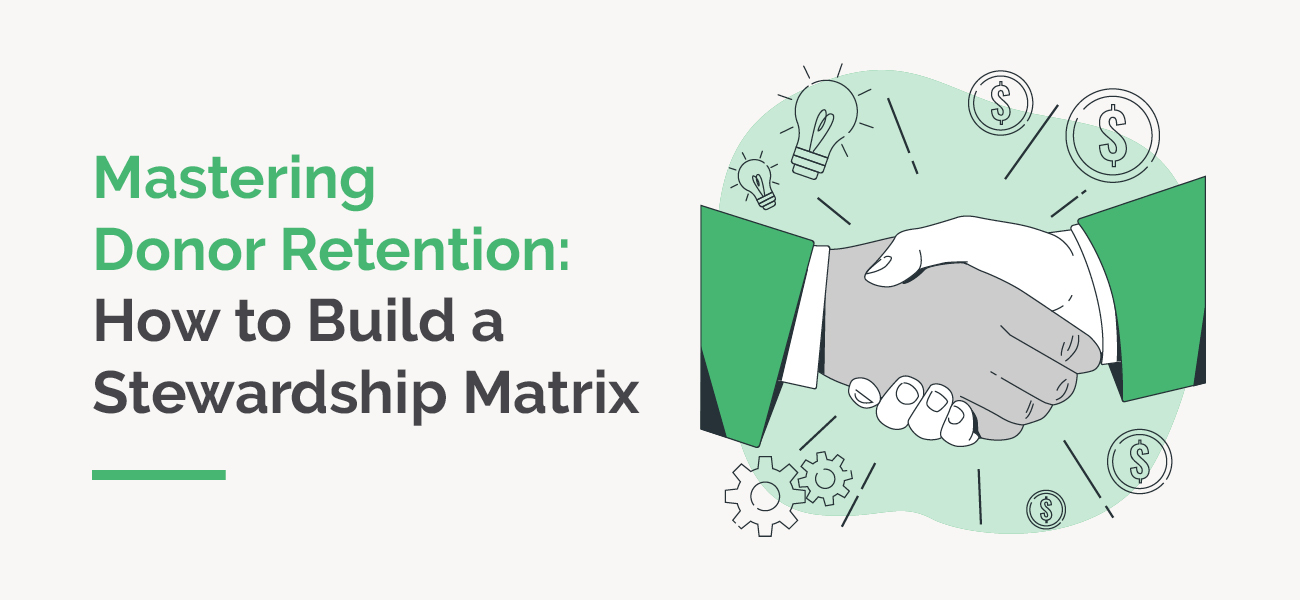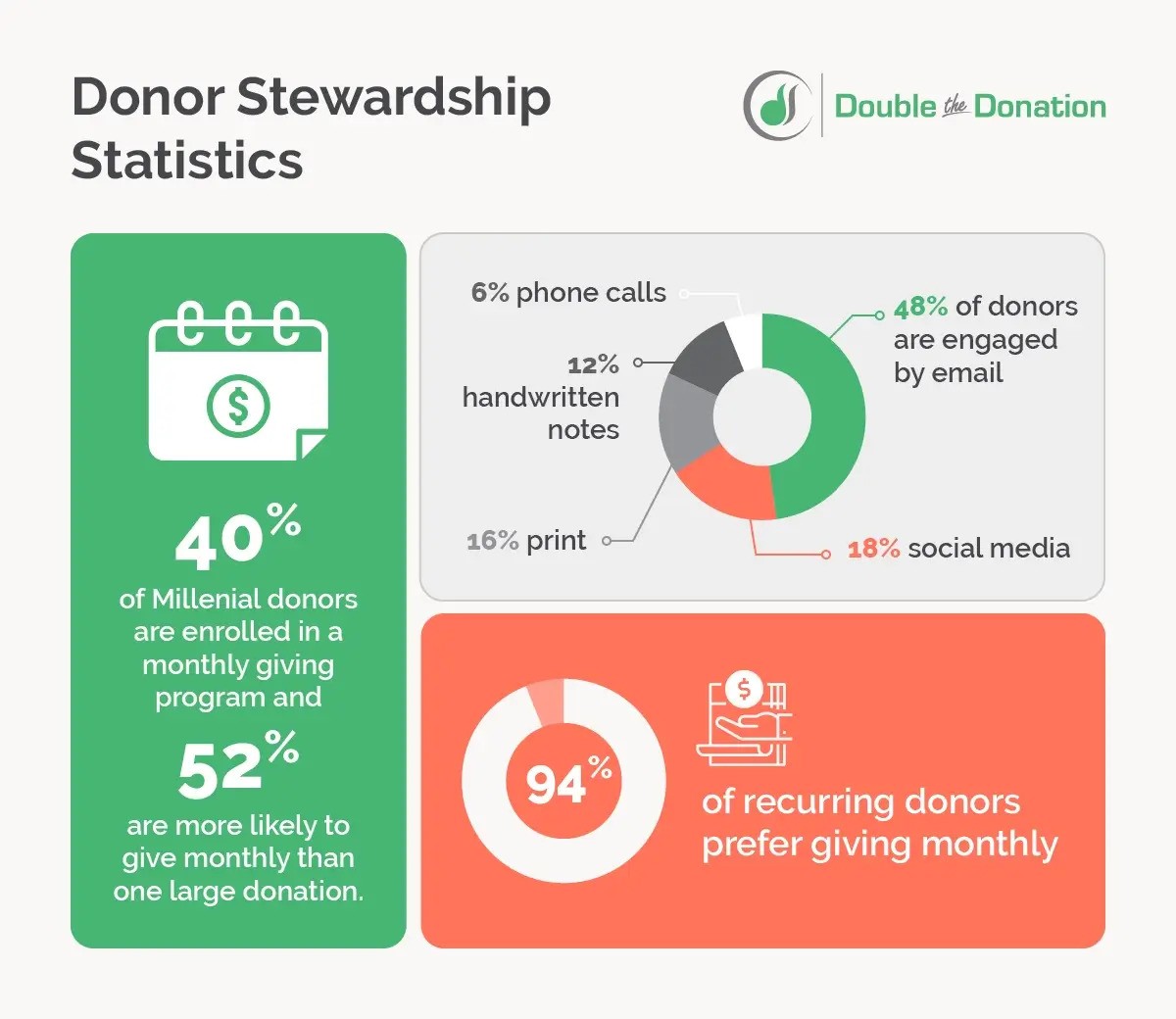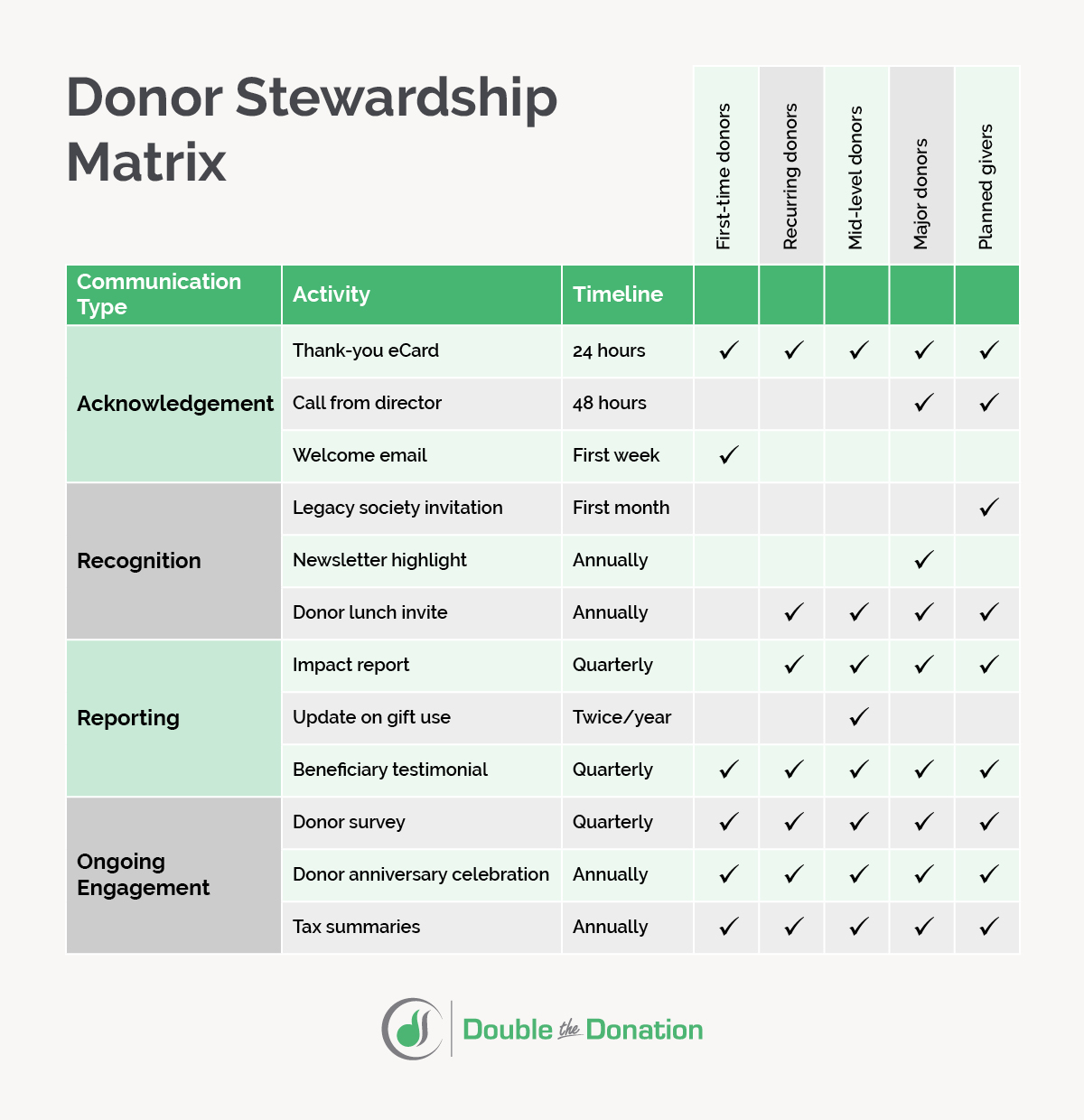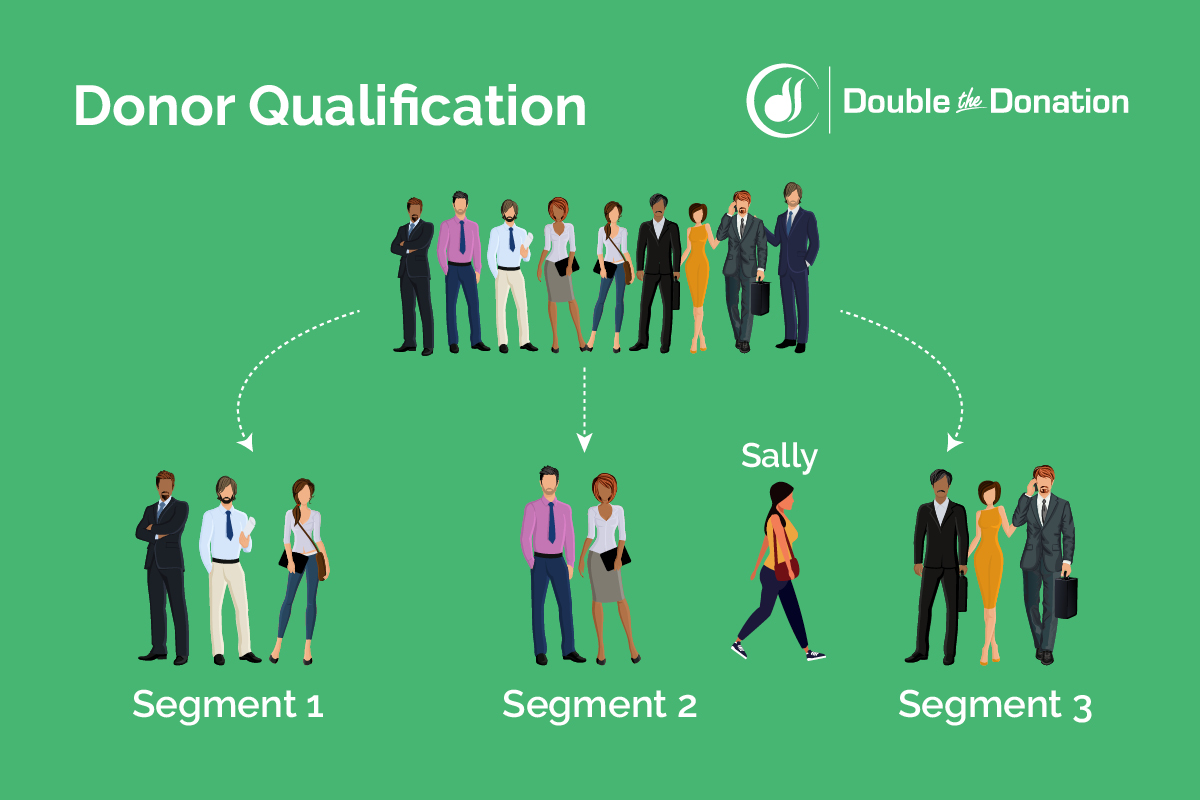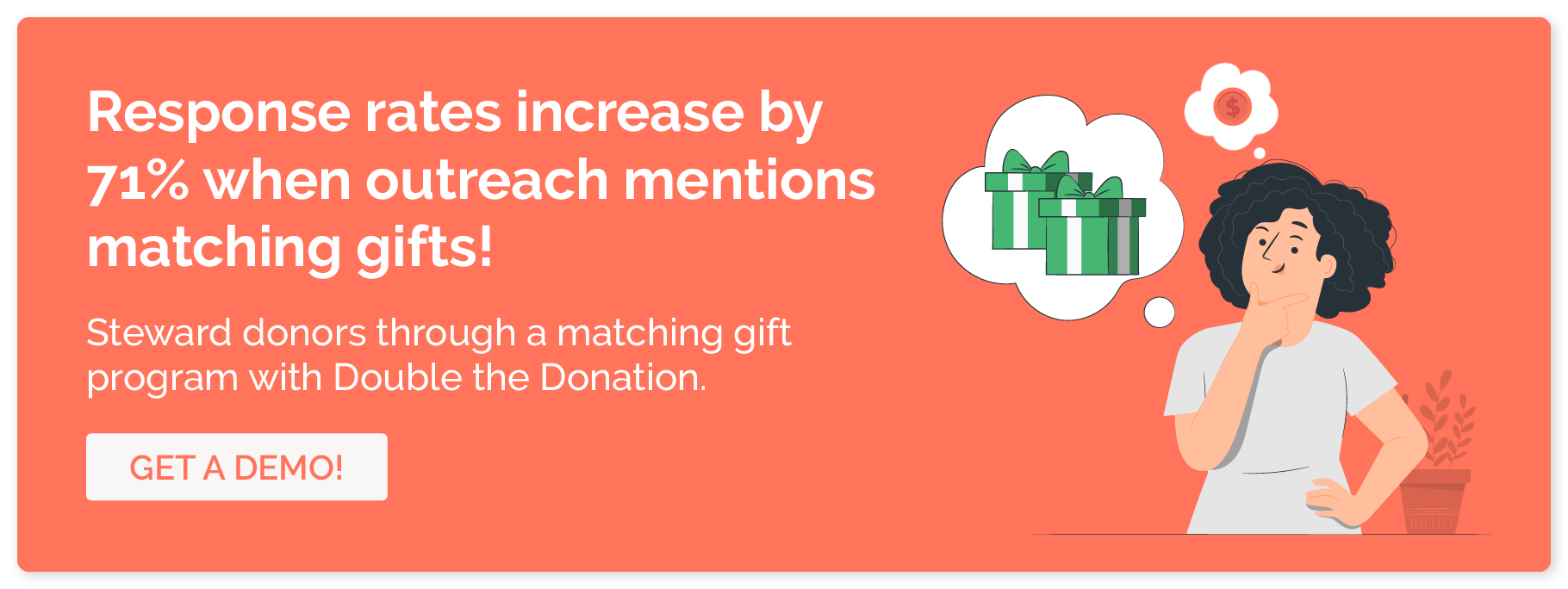Mastering Donor Retention: How to Build a Stewardship Matrix
Nonprofits thrive on the generosity of committed donors, whose loyalty funds their mission-related work year after year. Not only do returning donors provide reliable support for nonprofits, but they also give 42% more than one-time donors on average.
But with retention rates hovering around 40% in recent years, your organization needs a clear plan for keeping your donors coming back. In this guide, we’ll explore how you can do just that by discussing a stewardship matrix in the following topics:
- What is a stewardship matrix?
- How to create a donor stewardship plan
- Stewardship matrix best practices
- Tools for increased donor stewardship
This means donor retention is not just a technique to raise more—it’s a necessity for fulfilling nonprofit missions! Let’s get started by defining a stewardship matrix.
What is a stewardship matrix?
A donor stewardship matrix is an outline of the method and cadence your nonprofit will use when reaching out to donors. This stewardship plan standardizes outreach by establishing a dedicated timeframe for engaging each donor.
As a nonprofit professional, you’re likely familiar with stewarding donors, or the process of building relationships with donors after they contribute to your organization. While there are plenty of tips available for nonprofit leaders about engaging donors more deeply, the only way to successfully master stewardship is with a comprehensive plan.
To prepare a donor stewardship matrix, your nonprofit will need to evaluate the following:
- Donor segments: Know the different appeals donors need to hear. For example, 40% of Millennial donors are enrolled in a monthly giving program and 52% are more likely to give monthly than to make one large donation. Your nonprofit might plan to promote monthly giving to this segment to increase the chances of these donors giving.
- Communication channels: 48% of donors say that regular email communications are most likely to keep them engaged and inspire repeat donations, followed by social media (18%), print (16%), handwritten notes (12%), and phone calls (6%). Leverage these channels accordingly to reach donors in a way they’re likely to respond to.
- Timeline: Knowing when and how frequently donors prefer to give can guide your requests. 94% of recurring donors prefer to give monthly, 3% weekly, 2% annually, and 1% quarterly.
When taking these details into account, your nonprofit can create personalized and meaningful communications for specific audiences. Let’s take a closer look at how to develop a stewardship plan.
How to create a donor stewardship plan
Acknowledging the need to steward donors is just step one. To craft a stewardship plan that effectively engages donors and secures their long-term support, follow these steps.
Segment your donors.
Your nonprofit’s stewardship efforts are based on its donor composition, meaning you must learn about the individuals that make up your supporter base to cultivate meaningful relationships with them. Start with an overview of your supporter base by visualizing donors’ current engagement levels in a pyramid format.
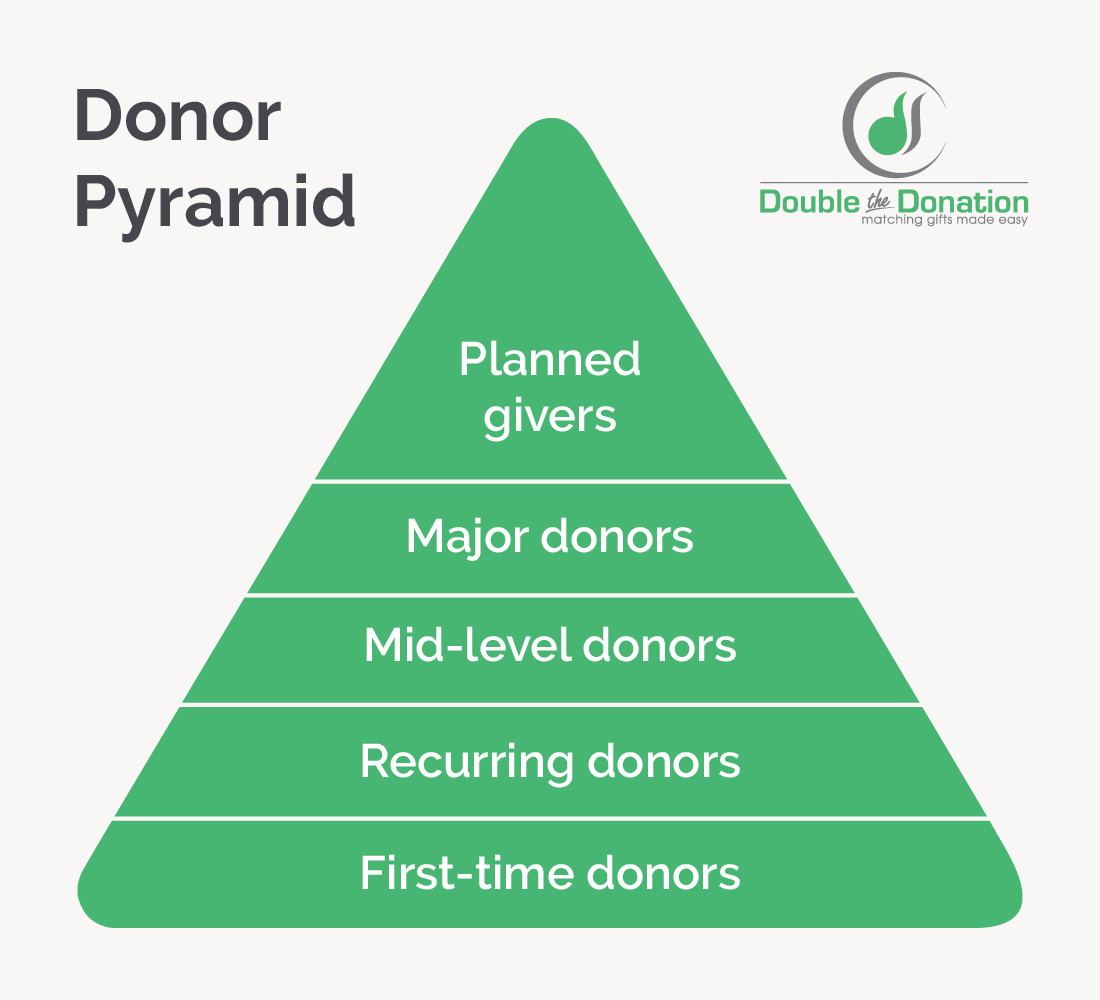
Your donor pyramid will be unique to your organization, but it can generally include first-time, recurring, and major donors. Keep in mind that the goal of your donor stewardship plan is to move supporters from lower levels of the pyramid to higher levels.
Along with these categories of giving levels, identify shared characteristics among your donors and group them into donor segments accordingly. Donors’ preferences and interests can help you more accurately target your outreach to appeal to them individually. Some common determinants of donor segments include:
- Demographics
- Involvement history
- Communication preferences
To create these segments, you’ll need thorough and accurate donor data. Collect information about your donors through surveys, donation forms, conversations at a fundraising event, or by hiring a data appending service. Then, implement a standardized process for inputting data into your nonprofit’s database. Ensure it stays up-to-date over time and free of errors or duplicate entries.
Determine communication types.
Using what you know about your donors, start developing ideas about how to best engage each group. You’ll need a well-rounded approach to successfully move donors up the pyramid. Consider including the following types of communication:
- Acknowledgment: Let donors know their involvement is noticed and appreciated by your nonprofit to immediately connect with them upon engaging with your organization.
- Recognition: Take acknowledgment a step further by thanking donors specifically for their contributions. Remind them that your mission would be impossible without them and make them feel like an integral part of your work.
- Reporting: 41% of donors say they would give again if they received personalized outreach on the impact of their support. Show supporters what their donations have accomplished to help them feel valuable to your organization, and show them what additional donations could accomplish to inspire further support.
- Ongoing engagement: Develop a plan for ongoing engagement that accounts for donor feedback. This includes direct donor engagement strategies, like inviting them to continue their involvement in a specific way, as well as opportunities for donors’ voices to be heard, like feedback surveys.
Your stewardship matrix will only be complete with several types of communication since a variety of messages are needed throughout the donor lifecycle to engage them in different phases of giving. Keep your donor segments in mind as you establish these communication types and determine which messaging each group would prefer to hear.
Brainstorm stewardship activities.
Narrow your stewardship strategy by getting specific with the actions you’ll take to send these messages. Within the above categories of communication types, create specific activities to deepen donors’ connections with your organization. Some highly engaging ideas include:
- Sending eCards for any occasion
- Offering other involvement opportunities
- Sharing impact reports
- Soliciting feedback
To make these activities even more engaging, plan messages outside of your typical donation request or follow-up. For example, a fun eCard on a donor’s birthday can show that you care about them as individuals, not just ATMs with legs.
Outline a donor stewardship matrix.
After establishing your donor segments and developing a list of activities to engage them, your nonprofit can officially create its donor stewardship matrix.
Break down your activities into the different types of communication we discussed earlier and create a timeline for when those communications will be sent out. While your donor stewardship plan will be unique to your nonprofit and its supporter base, you can use the following template and steps as a guide to organize your communications:
- List out your communication types. These are the focuses of communication you outlined after donor segmentation, such as recognition or reporting.
- Assign activities to each communication. Create communication activities to achieve each of the goals listed in the previous step.
- Specify a timeline for each activity. Determine a deadline for each activity to be completed that ensures maximum engagement. For example, you’ll want to thank a donor within 24 hours of receiving their donation to show you value their gift and keep your organization top of mind.
- Assign donor segments with activities. List out your groups of donors and mark which ones should be engaged with each activity. For example, a welcome email would help first-time donors feel welcomed into your organization, but this wouldn’t apply to recurring donors who have been part of your nonprofit for years.
Remember that this donor stewardship plan will integrate with your organization’s overall communications strategy. Be careful not to overwhelm donors by ambushing their inboxes with thank-yous, donation appeals, and other communications.
The best way to organize your communications plan is to designate a specific stewardship committee within your marketing team. This way, those in charge of your stewardship plan will have an understanding of your overall communications and the resources to coordinate with your communications team so that the timing is well-planned.
Implement your donor stewardship plan.
After explicitly laying out your stewardship matrix, it’s time to put your plan into action! Immediately begin the process with newly-acquired donors and track your communications with them.
For existing supporters, use your newly created donor segments to launch stewardship efforts with them, as well. Be careful to track each communication and add special notes about interactions where relevant. This way, you’ll get to know your supporters even better and track their engagement with your organization over time.
Stewardship matrix best practices
Consider these additional tips for making the most of your stewardship matrix.
Regularly qualify your donors.
Imagine this: Sally, a senior in college, is a new donor who contributed to your nonprofit for the first time this year. You successfully steward her, and she continues to give frequently for the next five years.
A lot can change in five years, which is why you’ll need to re-evaluate your donor segments over time to ensure each donor is properly categorized. Sally, for example, might enter an entirely new segment after graduating college, getting a new job, and potentially going through other life changes, such as moving to a new city.
Donor qualification is the process of analyzing your donor segments and allows your nonprofit to keep an eye on its changing donor base. Ultimately, you’ll be able to uncover new stewardship opportunities by keeping track of donors’ life changes, not only by properly segmenting them but also by knowing them on a personal level.
Re-evaluate your plan over time.
Stewardship is a cycle in that as you learn more about donors through your donor stewardship plan, your activities and efforts should evolve. Regularly evaluate which areas can be improved and how you can strengthen relationships with your donors.
To do this, gather feedback from donors and your stewardship team. Donors can provide insight into how your current stewardship plan makes them feel, but your team’s feedback is similarly necessary for determining how their roles impact your plan and what areas for improvement they’ve identified.
Create giving societies.
Make it easy for donors to increase their engagement with clearly defined giving societies. Establish a donation amount required for membership (or an annual membership fee) to encourage donors to give more. In exchange, they’ll receive benefits associated with the membership, such as exclusive merchandise branded to your organization or access to VIP events.
By incorporating giving societies into your stewardship strategy, you’ll add an element of prestige to donating. Plus, this helps to cultivate a stronger community of supporters when members mingle at events and get to know each other better.
Tools for increased donor stewardship
While a thoughtful stewardship plan can significantly improve donor retention, the right tools can supplement your plan by streamlining your efforts.
Donor-facing technology
Whether your stewardship communications prompt donors to take a certain action or simply information, you’ll need to ensure they can receive your message and act on it easily. Consider the following donor-facing tools for your strategy:
- eCards: Make your communications more engaging with digital greeting cards branded to your organization. These cards, typically sent via email, can be sent for any purpose, including celebrating holidays, acknowledging donations, or even collecting donations when supporters send eCards to friends and family members in exchange for a small donation to your nonprofit.
- Accessible website: Many of your communications will send donors back to your website since it’s a hub for all the most important information about your nonprofit. Ensure your website is easy to navigate and follows your stewardship strategies, using elements such as beneficiary testimonials to make donors feel valued and important.
- Matching gift auto-submission: Matching gifts are a proven way to engage donors, with 84% of donors saying they’re more willing to donate if a match is offered. Embedding an auto-submission tool on your nonprofit’s website makes it easy for donors to check their eligibility and submit a match request, instantly doubling or tripling the impact of their gift.
In addition to making match requests a breeze, auto-submission tools can further show donors that you’re working to maximize their gifts and drive real impact with every contribution, especially when paired with background information about the significance of a matching gift program. For more information on how to leverage such a tool, watch the video below:
Data management tools
To create donor segments and ultimately plan communications for your unique supporter base, you’ll need organized data in an easily navigable platform. Consider investing in a constituent relationship management (CRM) solution to manage your donor data and details about their contributions.
Depending on the solution you choose, some CRMs even automate many of the stewardship processes for you, such as donor segmentation or sending communications. These tools can even compile reports to make it easier for your nonprofit to draw insights from your donor data.
Online giving software
Various giving tools can make online donating easier for your donors by creating donation forms, safely processing payments, and automating donation receipts. According to Getting Attention, these tools can also simplify donor data collection for your nonprofit by collecting contact information, giving preferences, and other important details.
Next steps for your donor stewardship plan
With a stewardship matrix, your nonprofit has a powerful and unique tool for donor retention. It unlocks your ability to deepen relationships with supporters and ultimately raise more, decreasing the chances of donors lapsing over time.
Be careful not to neglect this tool as your supporter base grows and evolves. To effectively steward donors, your plan must also grow and evolve. Use the right technology, leverage valuable donor data, and always look ahead to identify other opportunities for engagement.
For more ideas and expert tips on stewardship strategies, check out these additional resources:
- How to Start A Donor Retention Program for Your Nonprofit. Now that you’ve learned everything you need to know about creating a stewardship plan, expand your efforts by establishing a complete retention program. Learn everything you need to know to get started in this guide.
- What Is Phone Number Appending? How the Process Works. Accurate donor data is crucial to every donor stewardship plan. Explore this guide to phone number appending so you can ensure your nonprofit has access to the most up-to-date contact information for each supporter.
- Matching Gift Videos | Examples and Best Practices. Donors are more willing to give (and willing to give more!) when they know their gifts will be matched. Learn how to promote matching gifts to donors and encourage them to deepen their involvement with your nonprofit!
